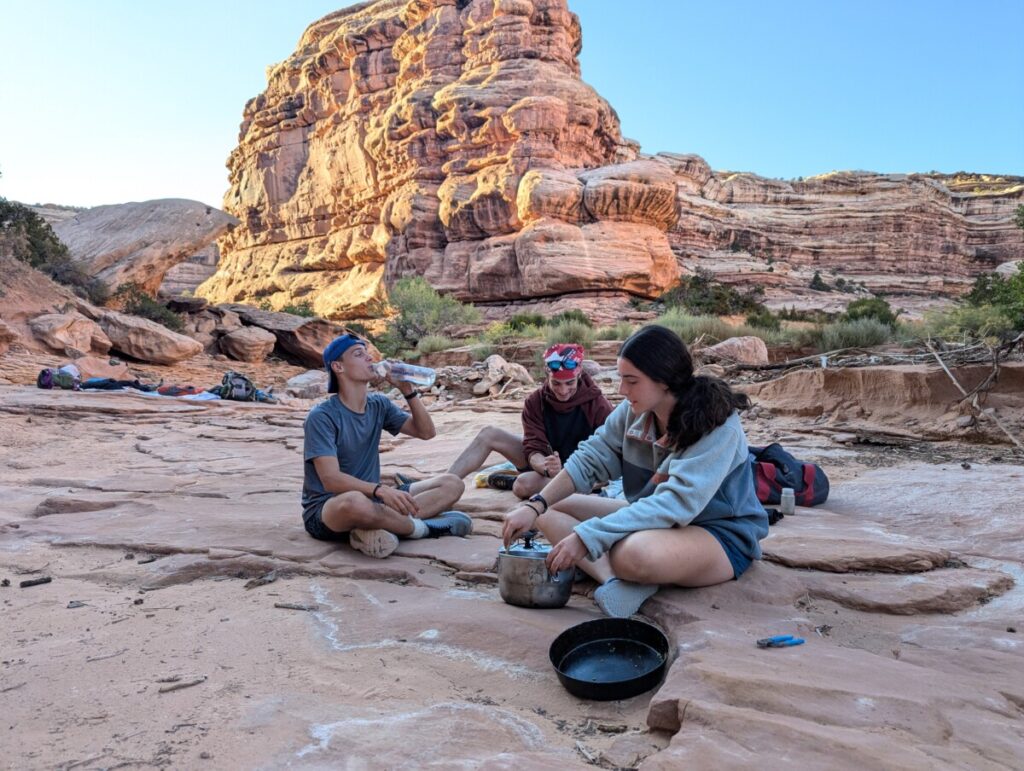
Waylon Zedonis
Enjoy the Ride: A Bus Trek to Utah
Going into our Second Expedition, we had an eight hour bus ride ahead of us all the way to the canyons in Utah, and another eight hour ride back. Initially, it sounded like a daunting experience. But, as we soon found out, it
was one of the best parts of our trip. The initial journey to Utah wasn’t very talkative at first, but we still knew each other enough to be social along the way. We even had a read aloud of Octavia Butler’s Parable of the Sower, our novel for English class, to pass the time. Our bus ride there was a great starting point for our expedition into the canyons.
Our journey back to HMI was an even better experience. The whole way back, we were talking, singing, playing
cards, and having a blast. As we got to know each other better in the canyons, time flew by incredibly quickly.
Our conversations were filled with jokes and memories from our expedition. While the bus ride initially seems
underwhelming, it was one of the best parts of my Second Expedition.

Xavier Rodriguez-Gould
A Place of Worship
The desert makes you fall to your knees. It might happen the first day, when you trip over a loose rock just a few feet from a sheer precipice. Or the last day, when you realize that despite the heat, despite your sore muscles, and despite the baby rattlesnake crawling towards your sleeping bag, you are going to miss this landscape: this mausoleum of extremity, this cathedral of sand and rock. The desert forces you to bond to the land. It exacts respect from every fiber of your being.
We come from hot showers and cold glasses of water at the press of a button or the turn of a handle, symptoms of a society in abject disconnect from its land and natural resources. The desert teaches you to appreciate where your luxuries come from. It simultaneously makes you acknowledge that they are just that—luxuries, foibles of a consumeristic society. However, as off-color Edward Abbey writes in Desert Solitaire, “[w]ilderness is not a luxury but a necessity of the human spirit.” Walking, climbing, and sometimes wading through the canyons was an experience to remember. Ten days in the desert gives you ten million reasons to protect it.
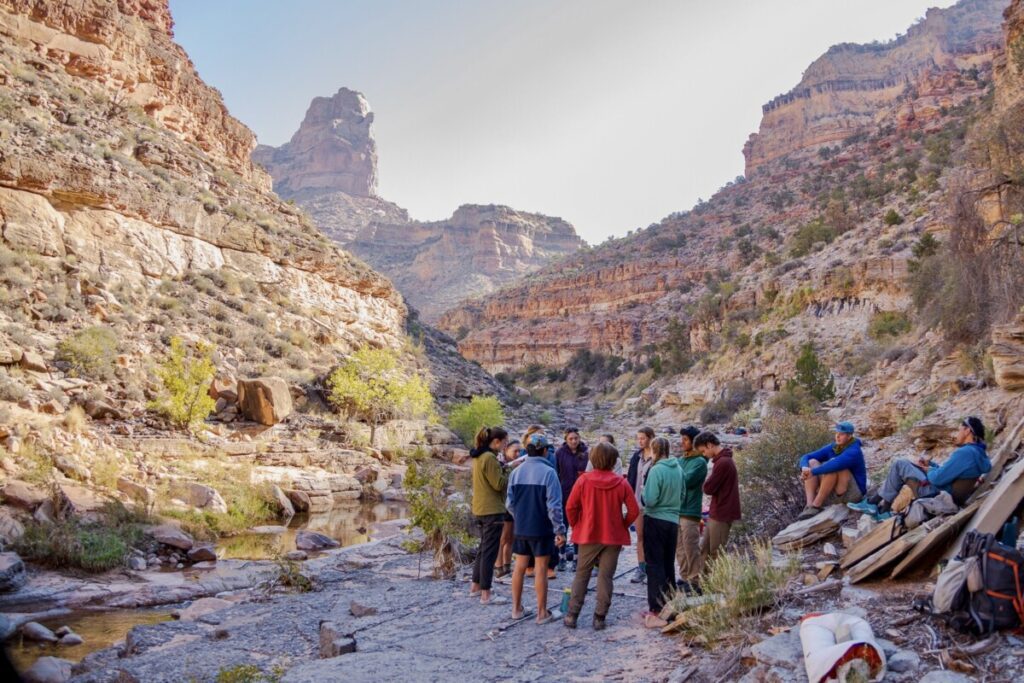
Stella Fenton
Map Checks and Canyon Walls
The red walls of Youngs Canyon, our world for two weeks, surrounded us as five of us crouched around a map.
Before map checks we always observed distinctive features around us: the walls of the canyon, big rock
formations, and the steepness of the trail. Someone pointed out a unique red rock in the distance; it was shaped like a hand with its middle finger pointing up to the sky. After observing, we get a better sense of what to look for on our map. That day in Youngs, we planned to climb up and out of the canyon to camp on top of the mesa. We easily trapped our location; we had plenty of practice reading canyon maps from the days prior, and Youngs has plenty of distinct features.
Still, we had trouble finding a good place to climb up to the mesa. From our vantage point, we thought of two options: climb up and contour around the edge of the canyon, or climb up and walk around the “middle finger” rock before hiking to the mesa. From the bottom of the canyon, it seemed impossible to go with the first option, and the rock looked so close. But a closer inspection of the map showed that it was a lot farther away, and a lot bigger than we first imagined. We came to the consensus that we needed to go “up and around”, and so we climbed up the canyon. This choice took us climbing up the side of the canyon, up steep precarious rocks. There was a moment when we were considering using ropes on a particularly scary section before retracing our steps to find a different path. It was physically and mentally draining, but our group made it up, and we looked out over to where we were sitting, reading our map only an hour ago, the joy of accomplishment encompassed us.
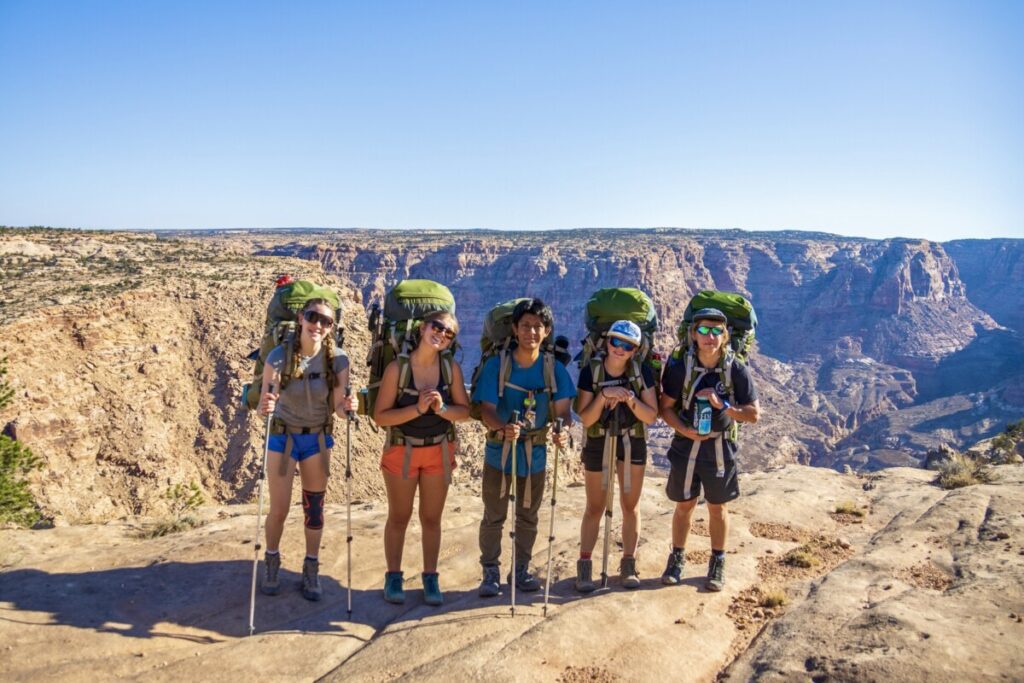
Abel Cruz
Mirages in the Desert…Or Oases?
Oh my god, oh my god, am I actually going to be drinking pothole water? I’m so thirsty, but I don’t want to use
up all my clean HMI water in one day. Oh my, what am I going to do? The water is going to look all brown and
muddy and taste like…. wait- is that a river?
That was my reaction to finding that there was a flowing river and lush plants in Dark Canyon, our second expedition route. At first, I was like “Huh? This isn’t what I expected at all.” But I didn’t really pay much attention to it. I mean, at least I knew I wouldn’t be drinking water that looked like someone destroyed their cup of morning coffee. And if it did taste a bit off, I’d have lemonade powder to make it taste better. Who knows? Maybe the river is only a mile long and then we’ll embark on our true canyon experience.
Well, believe it or not, I was wrong. The next day, after half a mile of hiking, one of the people in my hiking
group had the great idea to swim in a deeper part of the Colorado River, which had a little waterfall flowing into
it. God, if only you could share the blissful feeling of swimming in that river after days of not showering. For the
rest of our trip, our exped group would set down our packs, take off our hiking boots, and swim in blue holes,
waterfalls, and rivers, laughing and having fun. I loved my expedition group, and I can’t wait to go back to the
canyons for 3rd exped!
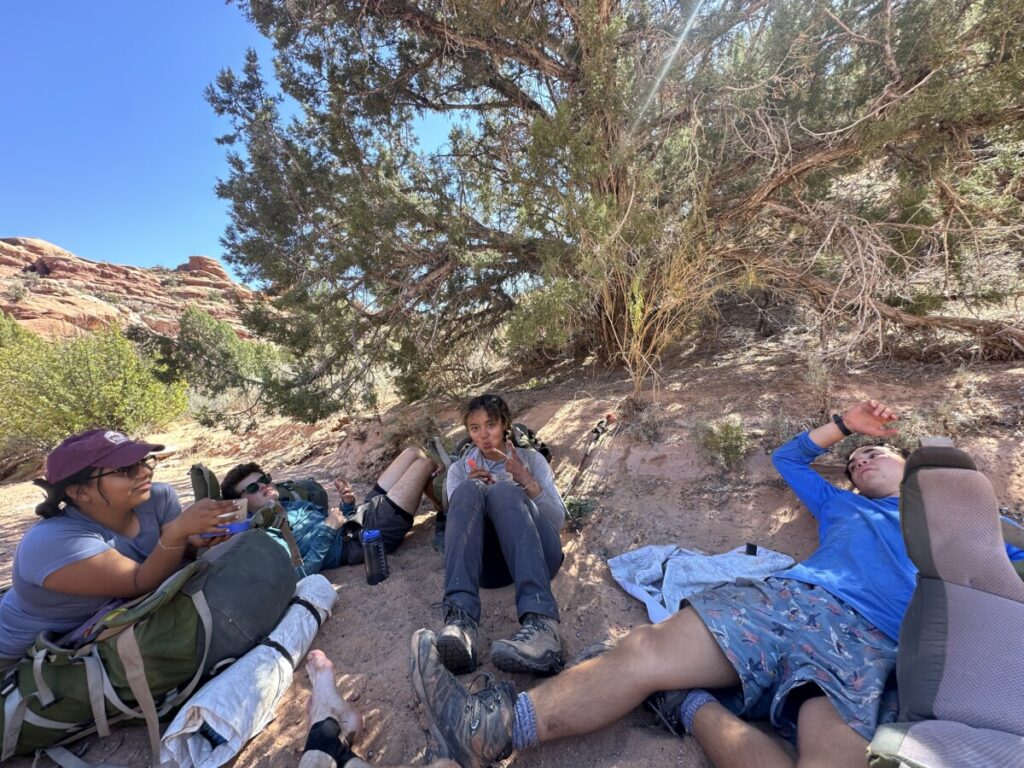
Gillian Booker
Cooking in the Backcountry
Before HMI, I cooked, but I never cooked constantly. My relationship with cooking was making a fancy meal
once a year when I felt like it, but otherwise I usually fixed myself a bowl of cereal and milk. Although I knew
how to cook, I never cooked anything creative: I would always follow a recipe. I felt like I did not know enough
about cooking to improvise. After all, I was scared of how much cooking relied on the creativity of the chef. This all changed when I lost the luxury of pot handles, a stove that doesn’t fall over, and fresh ingredients.The
backcountry forced me to be creative and use my mind to make a delicious meal. In the Sawatch Mountains, I
learned that you don’t actually need to know that much about cooking to experiment. Holding a pot with pliers,
on a tiny whisper light (that I had to hit to make work), with rationed dry food sparked my love for cooking.
With this newfound love for cooking, I came to my second expedition with confidence. I thought I knew how to
improvise and cook in the backcountry, and I felt like I could do anything. Then, I realized my cook group
would have a new dietary restriction: no gluten. In this new cook group, I was forced to go out of my comfort
zone again, and I learned how to utilize and substitute different ingredients. For example, we used quinoa instead of pasta to make “mac-and-quinoa.” Luckily, there were still some dishes that happened to be gluten free. One of my cook group’s member’s favourtie meal was my gado-gado. In retrospect, I’m glad I was placed in the gluten free group because it challenged me as a cook and a person again. Not only has being on an HMI cook crew increased my confidence in cooking, it also sparked my new found love for the craft of food.
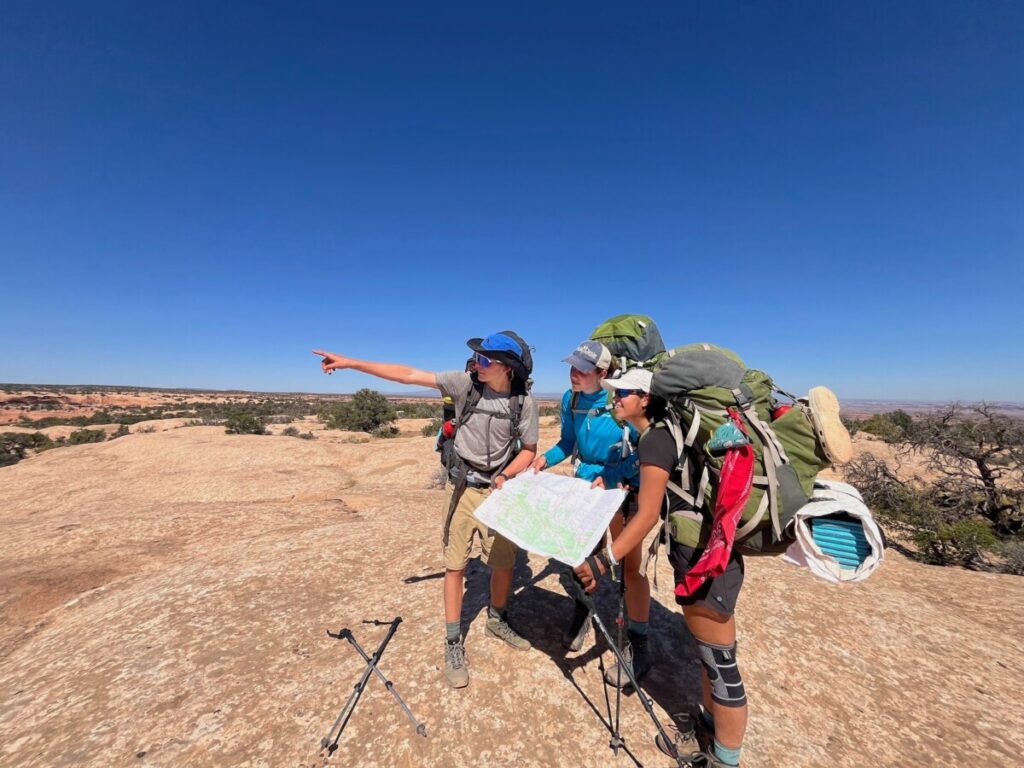
Quinn Barach
Space For Connection
Many things set HIM apart from other schools, but there’s not a value as important as connection. HMI
encourages us to mingle with each other, talk with new kids frequently, switch up our tables at meals, and play
games. But nothing bonds us with each other quite like our Expeditions (expeds). Expedition is a time where we connect with the outside world. We go on a two week trip where we backpack every day with friends and faculty. There are many times to talk with the people around us , get to know the group we’re living with, and feel comfortable around everyone.
Every night after dinner, we have Circle; this ritual is a deeply authentic time for listening and sharing. Circle takes place on campus, too, but it feels particularly powerful on Exped. It is a space to engage with peers. It typically starts with a game, which changes most nights. Then, we review the “Plan for Tomorrow” and share our “kudos,” a space that gives us the opportunity to compliment each other. This connection gives us a chance to show gratitude to each other, while receiving affirming praise. We continue our kudos with “KQCC”: a space to share more kudos, questions, comments and concerns. It’s a fun way for us to engage with each other and share our thoughts.
The most important part of Circle is the circle question, which is asked by the faculty and occasionally students. These questions range from simple questions such as, “what’s your favorite book and why?” to deep questions that force us to share meaningful parts of our lives so the rest of the community can get a better understanding of who we are as a person. Circle is a time for reflection: to debrief our day as we form relationships through thoughtful questions and responses.

Nina Bakal
Unbreakable Bonds
One of the most powerful things about expedition is the strong friendships we build out in the field, a
combination of both group and individual bonds that we carry back to campus.
When I first came to HMI, building solid relationships with completely brand new people was definitely a worry at the forefront of my mind. I feared being out in the wilderness with a group of people I didn’t fully know and trust yet. Within just 24 hours of being on expedition, these fears dissipated quickly and completely. The pure nature of HMI’s trips brings people out of their shells immediately, and the superficial social barrier that often takes longer to break down easily crumbles. Specifically, on second expedition, I found that being in a smaller group of just six students helped build a close-knit dynamic. I had the chance to get to know every person, their passions, and important aspects of their authentic selves. At the same time, I felt like everyone on the trip got a grasp of who I really am, particularly my values and passions. Having to work together and learn to rely on each other through a physically and emotionally challenging trip creates extremely durable friendships, and I am grateful to have those now that we’re back on campus.